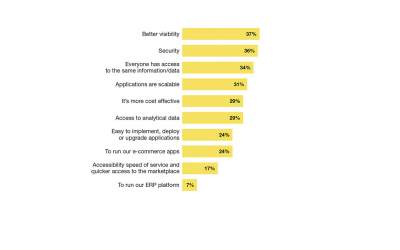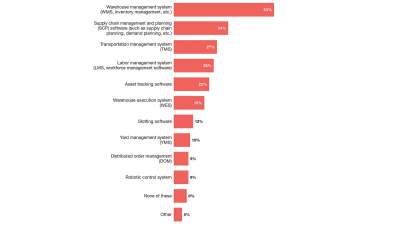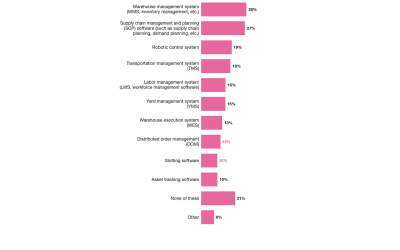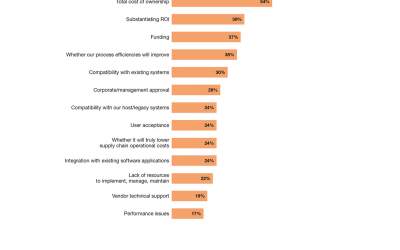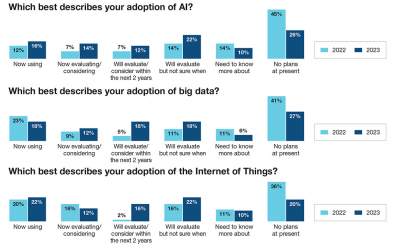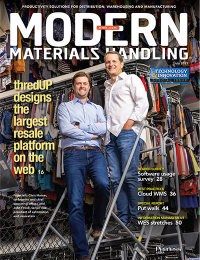Software usage survey: Spotlight on technology
Artificial intelligence may be the hot technology of the day. But it’s not alone. Our latest survey plots the trajectory of AI and other advanced technologies along with warehouse, transportation, labor and planning software. Here’s the rundown of where they stand in the plant and warehouse right now.
At this point in time, software is a given in materials handling operations. Right? Well, maybe not everywhere.
“We are an outdated traditional warehouse operation that relies on limited technology and lots of pen and paper to get work done each day. The fact that we have not already adopted any sort of support systems has greatly hampered our growth,” a respondent to our latest usage survey wrote.
That’s a strong take on the value of technology in today’s materials handling operations. From a non-user, no less. And while that commentary from one company sounds like a one off, it may not be as rare as you would like to think.
According to Modern’s latest “Materials Handling Technology Study,” 40% of companies say they typically take a wait-and-see approach (21%) or are among the last to adopt technology (19%).
But what about how the other 60% describe themselves? About 16% say they are innovators, 13% are early adopters and 30% cautiously embrace change.
To put it another way, technology in the plant and warehouse continues to advance at a measured pace. It’s important to keep in mind that the idea is not to keep up with technology for its own sake. Rather, the game is to integrate warehouse, transportation, labor and planning software with operations as they ship each day’s orders.
And that’s exactly what’s happening.
At the same time, it’s clear that artificial intelligence (AI) as well as cloud computing, big data and the Internet of Things are all becoming part of the now and future productivity equation.
This is what you and other operations managers are telling us. The data in this article is from a survey of our readers conducted for Modern by Peerless Research Group in April. All respondents are personally involved in using, evaluating or purchasing software for their company’s materials handling operations.
Level of involvement
Let’s face it, the software we’re talking about here is not exactly in the same stage of development as crypto currencies. Warehouse management systems (WMS), transportation management systems (TMS), labor management systems (LMS) and related planning systems have been in place at many companies for longer than 20 years.
They’re well established and have always delivered a range of benefits. These include improved operations, fewer glitches in processes, higher efficiency, reduced expenses and faster deliveries, to name some of the most common ones.
When it comes to return on investment (ROI), the payoff is quick. Both WMS and planning solutions delivered their ROI in 18 months or less at 45% of companies. For TMS, 73% hit their return target in the same time period.
That said, materials handling related software use has remained fairly steady as of late. In the past year, 39% of users increased their reliance on software. Fifty-seven percent stayed level, while 4% became less reliant on the software.
By the way, those numbers have remained fairly steady since the 2020 survey. However, it’s worth noting we saw a spike in 2021 when 48% of companies increased their use of software. Probably an outcome of the first year of the pandemic and the pressures on operations that resulted.
Which made us wonder how has the current climate changed companies’ approach to software?
The three big buckets here are:
- 24% plan to upgrade existing software instead of buying new software packages;
- 25% are moving forward with new software investment this year, and;
- 28% are scrutinizing software investments and moving forward cautiously.
That’s a very active level of engagement for software investments by any measure. In fact, only 19% have applied the brakes. Without saying what their buying proclivities are, another 13% have decided software evaluations are better outsourced than handled in house.
What’s the top dog?
Which brings us to the first major compilation of exactly what software is at work in facilities.
The chart “Which of the following software applications are currently in use in your warehousing and distribution environment” identifies the top 10 software types in place. As would be expected, WMS leads the pack at 63% of facilities. And the drop off from there is actually quite dramatic. Supply management and planning software is at 34% of companies, TMS at 27% and LMS at 25% of companies.
Meanwhile, companies have a range of plans to evaluate, purchase or upgrade within the next 24 months. As the chart on this page shows, WMS once again is the top dog with 28% of users planning to adjust their software. Supply chain planning comes in second at 27% while LMS is pegged at 15%.
At the same time, companies clearly understand that despite the benefits of this software there are challenges. Total cost of ownership is the No. 1 hurdle to justifying the technology at 54% of companies. Funding the project is cited by 37% and is the second biggest challenge. And integration with existing software applications is the third biggest concern at 24%.
Specifics on WMS, TMS and planning software
Let’s start here with WMS.
Thirty-eight percent of respondents say they have had WMS for less than 10 years. And 17% for 15 years or more.
Upgrades are certainly on their minds. Sixty-two percent have upgraded their WMS in the past five years. And 7% haven’t upgraded, however, it’s unclear how long those 7% have had WMS in place.
So, what attracts companies to WMS? Real-time control comes in at 49%, almost exactly the same as in last year’s survey. Other operational reasons for upgrading are inventory deployment (36%), labor management (33% and a significant drop from 50% last year), new picking requirements and slotting (both at 28%) and yard management (18%).
When it comes to TMS, the vast majority of users (78%) have had it in place less than 10 years. And 77% have upgraded in the past five years, too.
And 5% of users have had supply chain management and planning solutions in place for longer than 15 years. They are using the software for demand planning (65%) and procurement (50%). Meanwhile, 40% have focused it on order management and collaborative forecasting, planning and replenishment. Interestingly, e-commerce fulfillment was the focus for 10% of respondents.
As to those technology upstarts
Needless to say, no matter how well established any of these software packages are, they don’t operate in a vacuum. So, we asked companies about their involvement with cloud computing, AI, big data and the Internet of Things.
Cloud computing is arguably the furthest along in its development among those technologies, but it also appears to have broadest user base, too.
In the current survey, 53% of respondents now run cloud-based applications. That’s up from 50% last year and 36% in 2021.
Another 28% are evaluating the cloud within the next 12 to 24 months. That’s a notable increase from 11% last year, which was a considerable drop off from the year before when 36% anticipated evaluation of cloud computing for their operations.
What’s just as notable is that cloud computing seems to be more top of mind than before. About 9% say they are not sure of their company’s interest in the technology compared to 13% in 2021 and 21% the year prior.
That could well be driven by clear applications and benefits of cloud-based computing.
Better visibility is cited as the top reason for the third year in a row. Close behind that is “everyone has access to the same information/data.” As ease of deployment is less important today, cost effectiveness of cloud computing is on a three-year run of increasing importance.
The survey also asked about what respondents were planning to link to cloud computing. Twenty-three percent plan to link it to lift truck data. Thirty-nine percent want to use it to manage information about or predict system failures of automated warehouse equipment. And the largest group, 49%, said they want to tie WMS, TMS, LMS and planning software into the cloud.
While the TV cable financial anchors seem to have first learned of AI in April, we all know it has been around in various degrees for some time. However, we’re still early in AI’s game.
About 16% of respondents said they are using the technology now. We didn’t pin them down as to where and to what end, but 16% is a solid start no matter how limited it might be. Another quarter of respondents are either evaluating AI now or plan to in the next couple of years. See the chart above for more details on AI’s trajectory in the plant and warehouse.
Big data and the Internet of Things are also getting their fair share of attention in facilities. Both are in the low 20% range of current use with both posting no plans for adoption by more than 35% of respondents.
So, from WMS to AI, technology continues to push its way deeper into manufacturing and distribution operations. And while we can all rest assured that assault will continue, what we can’t imagine quite yet is how these technologies will change those operations. Time to keep evaluating and upgrading.

Article Topics
Peerless Research Group News & Resources
2024 Intralogistics Robotics Survey: Robot demand surges 2024 Warehouse/DC Outlook Survey: Cautious, but seeking efficiencies We love research The employee satisfaction survey: Don’t worry, be happy MRO Survey: Finding and keeping the best technicians 2024 Automation Study: How automation is transforming the warehousing landscape Top 20 Warehouses 2023: Demand soars and mergers slow More Peerless Research GroupLatest in Materials Handling
Geek+ and System Teknik deploy PopPick solution for pharmacy group Med24.dk Beckhoff USA opens new office in Austin, Texas Manhattan Associates selects TeamViewer as partner for warehouse vision picking ASME Foundation wins grant for technical workforce development The (Not So) Secret Weapons: How Key Cabinets and Asset Management Lockers Are Changing Supply Chain Operations MODEX C-Suite Interview with Harold Vanasse: The perfect blend of automation and sustainability Consultant and industry leader John M. Hill passes on at age 86 More Materials HandlingAbout the Author
Subscribe to Materials Handling Magazine

Find out what the world's most innovative companies are doing to improve productivity in their plants and distribution centers.
Start your FREE subscription today.
April 2024 Modern Materials Handling

Latest Resources


